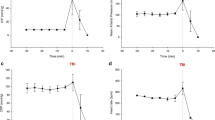Summary
We investigated the pathophysiological and morphological responses of anaesthetized rats to fluid percussion brain injury generated by an original midline fluid percussion injury device. Following different grades of trauma, lCBF was measured continuously in the right parietal cortex through a burr hole using laser Doppler flowmeter, and physiological parameters were monitored. Pathological changes also were evaluated microscopically.
During the first 2 hours following trauma, we found four patterns of cerebral circulatory responses. Little measurable pathophysiological response occurred after percussion pulses of less than 1.33 atmospheres (atm). In animals subjected to pulses of greater than 4.30 atm, lCBF increased synchronously with blood pressure, and then both parameters decreased continuously until death. In animals subjected to pulses of 1.53 to 2.33 atm, trauma produced a transient increase in 1CBF with no synchronous rise in blood pressure. In animals subjected to pulses of 2.70 to 3.87 atm, lCBF increased synchronously with blood pressure immediately following the injury, but had decreased markedly by 60 seconds and remained below the pre-injury baseline. Blood pressure recovered to baseline within 4 minutes of the injury. The transient increase in lCBF occurred within 5 seconds following percussion pulses of greater than 1.53 atm and appeared to be independent of the rise in systemic blood pressure. Apnoea occurred in animals subjected to pulses of greater than 1.53 atm, and the duration of apnoea and mortality rate correlated with the magnitude of the applied injury. A power decrease in the electroencephalogram post-injury and a delay in its recovery, both depended on the magnitude of the injury with few regional differences in the beta-2 band power. The distribution and extent of blood-brain barrier disruption and small haemorrhages also correlated with the magnitude of the injury. The number of neurons decreased significantly in both hippocampi by 2 weeks following moderate trauma. The four patterns of lCBF changes demonstrated in the present study, as well as the other responses to injury, may be useful for studying graded models of various diffuse brain injuries.
Similar content being viewed by others
References
Antal J, d'Amore A, Nerozzi D, Palazzesi S, Pezzini G, Loizzo A (1992) An EEG analysis of drag effects after mild head injury in mice. Life Sci 51: 185–193
Bouma GJ, Muizelaar JP, Stringer WA, Choi SC, Fatouros P, Young HF (1992) Ultra-early evaluation of regional cerebral blood flow in severely head-injured patients using xenon-enhanced computerized tomography. J Neurosurg 77: 360–368
Cortez SC, McIntosh TK, Noble LJ (1989) Experimental fluid percussion brain injury: vascular disruption and neuronal and glial alterations. Brain Res 482: 271–282
DeWitt DS, Jenkins LW, Wei EP, Lutz H, Becker DP, Kontos HA (1986) Effects of fluid-percussion brain injury on regional cerebral blood flow and pial arteriolar diameter. J Neurosurg 64: 787–794
DeWitt DS, Prough DS, Taylor CL, Whitley JM (1992) Reduced cerebral blood flow, oxygen delivery, and electroen-cephalographic activity after traumatic brain injury and mild hemorrhage in cats. J Neurosurg 76: 812–821
Dixon CE, Lyeth BG, Povlishock JT, Findling RL, Hamm RJ, Marmarou A, Young HF, Hayes RL (1987) A fluid percussion model of experimental brain injury in the rat. J Neurosurg 67: 110–119
Kontos HA, Wei EP (1986) Superoxide production in experimental brain injury. J Neurosurg 64: 803–807
Lewelt W, Jenkins LW, Miller JD (1980) Autoregulation of cerebral blood flow after experimental fluid percussion injury of the brain. J Neurosurg 53: 500–511
Lewelt W, Jenkins LW, Miller JD (1982) Effects of experimental fluid-percussion injury of the brain on cerebrovascular reactivity to hypoxia and to hypercapnia. J Neurosurg 56: 332–338
Mclntosh TK, Noble L, Andrews B, Faden AI (1987) Traumatic brain injury in the rat: characterization of a midline fluid-percussion model. CNS Trauma 4: 119–134
Meyer JS, Kondo A, Nomura F, Sakamoto K, Teraura T (1970) Cerebral hemodynamics and metabolism following experimental head injury. J Neurosurg 32: 304–319
Nilsson B, Nordstrom C-H (1977) Experimental head injury in the rat. Part 3: Cerebral blood flow and oxygen consumption after concussive impact acceleration. J Neurosurg 47: 262–273
Qian L, Ohno K, Maehara T, Tominaga B, Hirakawa K, Kuroiwa T, Takakuda K, Miyairi H (1993) Cerebral circulatory responses to fluid percussion brain injury in rats. Adv Exp Neurotrauma Res 5: 39–41
Saunders ML, Miller JD, Stablein D, Allen G (1979) The effects of graded experimental trauma on cerebral blood flow and responsiveness to CO2. J Neurosurg 51: 18–26
Shibata M, Einhaus S, Schweitzer JB, Zuckerman S, Leffler CW (1993) Cerebral blood flow decreased by adrenergic stimulation of cerebral vessels in anesthetized newborn pigs with traumatic brain injury. J Neurosurg 79: 696–704
Tanno H, Nockels RP, Pitts LH, Noble LJ (1993) Immunolocalization of heat shock protein after fluid percussive brain injury and relationship to breakdown of the blood-brain barrier. J Cereb Blood Flow Metab 13: 116–124
Yamakami I, McIntosh TK (1989) Effects of traumatic brain injury on regional cerebral blood flow in rats as measured with radiolabeled microspheres. J Cereb Blood Flow Metab 9: 117–124
Yamakami I, McIntosh TK (1991) Alterations in regional cerebral blood flow following brain injury in the rat. J Cereb Blood Flow Metab 11: 655–660
Wagner KR, Tornheim PA, Eichhold MK (1985) Acute changes in regional cerebral metabolite values following experimental blunt head trauma. J Neurosurg 63: 88–96
Author information
Authors and Affiliations
Rights and permissions
About this article
Cite this article
Qian, L., Ohno, K., Maehara, T. et al. Changes in ICBF, morphology and related parameters by fluid percussion injury. Acta neurochir 138, 90–98 (1996). https://doi.org/10.1007/BF01411731
Issue Date:
DOI: https://doi.org/10.1007/BF01411731




